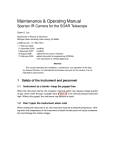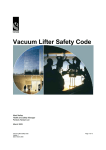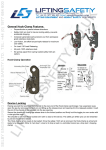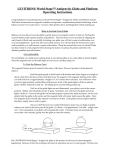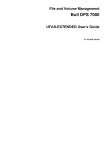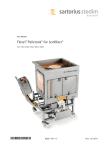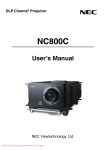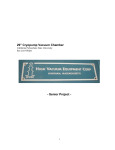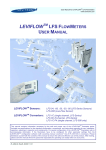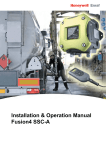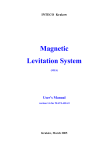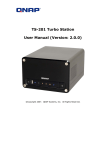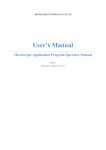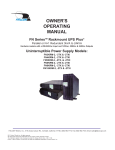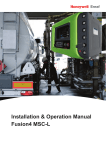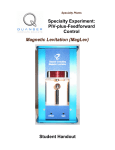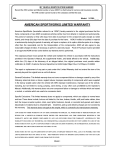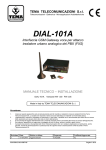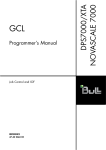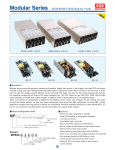Download SL-29310 - Emerson Network Power
Transcript
DISCONTINUED PRODUCT Liebert® FS Flywheel Energy Storage System™ GUIDE SPECIFICATIONS for a DC Flywheel Energy Storage System to be Integrated or Retrofitted With an Uninterruptible Power Supply System 1.0 GENERAL 1.1 SUMMARY This specification document covers the performance and construction requirements for a DC Flywheel Energy Storage System to be integrated with or retrofitted into Uninterruptible Power Supply (UPS) systems. The DC Flywheel is a mechanical battery that stores energy in the form of a rotating mass. The DC Flywheel shall be configured as a two terminal Energy Storage System and shall be used as a functional replacement or an availability supplement for a bank of chemical batteries for UPS systems. Like a chemical battery bank, it shall receive recharge and float power from the two terminal UPS DC bus and shall return power to the same DC bus whenever the bus voltage drops below a programmable threshold level. 1.2 STANDARDS 1.2.1 North America The DC Flywheel and all associated equipment and components shall be manufactured in accordance with the applicable sections of the following standards: • National Electric Code (NEC) • National Electrical Manufacturers Association (NEMA) • Occupational Safety & Health Administration (OSHA) The DC Flywheel shall be listed by a recognized certifying agency and meet the applicable requirements of the following standards: • UL 1004, Standards for Motor Generator Equipment • UL 1248, Standard for Engine/Generator Assemblies • UL 508, Standards for Industrial Control Equipment • CSA C22.2 No. 100-04, Motors and Generators • CSA C22.2 No. 14-95, Industrial Control Equipment 1.2.2 Europe For distribution in Europe, the DC Flywheel shall be CE-marked and meet the applicable requirements of these European directives and their applicable amendments: • 73/23/EEC, Low Voltage Directive • 98/037/EEC, Machinery Directive • IEC/EN 60439-1:1999, Low-voltage switchgear and control gear assemblies, Part 1 • IEC/EN 60204-1:1997, Safety of machinery - Electrical equipment of machines Part 1: General requirements • EN 1127-1:1997, Explosive atmospheres: Explosion prevention and protection, Part 1 • Machinery Directive Annex 1, Essential Health and Safety Requirements Relating to the Design and Construction of Machinery and Safety Components • 89/336/EEC, Electromagnetic Compatibility (EMC) Directive SL-29310_REV05_03-10 1 Guide Specifications Liebert FS 1.3 SYSTEM DESCRIPTION The DC Flywheel shall deliver power and energy to the DC bus of a UPS system when utility input power sags or is interrupted. The DC Flywheel shall store energy kinetically in a high-speed, carbon/glass fiber composite rotor rotating in a vacuum. No vacuum pump external to the evacuated housing assembly shall be required. The DC Flywheel and rotating group shall be fully levitated and centered by an active magnetic levitation system that minimizes idling losses and eliminates mechanical bearing maintenance and replacement. The motor-generator shall be a synchronous reluctance type that minimizes idling losses. The DC Flywheel shall be designed for a life in excess of 15 years in a UPS application. 1.3.1 Design Requirements UPS Manufacturer: _____________ UPS Model: _____________________ UPS Rating: _______kVA, ____________kW UPS Minimum Rectifier Walk-In Time*: _________ seconds UPS DC Bus Nominal Voltage: _______ VDC DC Flywheel Rating: _____kW, ________seconds * Rectifier Walk-In Time is the time required for the load to be returned to utility power following the period when the load was on battery or on flywheel. 1.3.2 Modes of Operation The DC Flywheel and all support systems shall be capable of storing and delivering up to 200 kW of power to the UPS DC bus at a nominal voltage 530 VDC or greater. The DC Flywheel shall operate in the following modes: A. Off Mode - When the DC Flywheel is initially powered on, it shall enter the OFF Mode and magnetically levitate its rotating group. A manual user command will make the system transition from OFF Mode to STARTUP Mode if all startup conditions are met. The DC Flywheel shall also enter OFF Mode at the end of a shutdown and shall transition automatically from SHUTDOWN Mode to OFF Mode. B. Startup Mode - In STARTUP Mode, the DC Flywheel shall charge (increase speed) up to the minimum operating speed (0% State of Charge (SOC)). At that point the DC Flywheel shall enter the CHARGE Mode. The DC Flywheel shall be in STARTUP Mode as long as (1) the flywheel speed is less than minimum operating speed; and (2) the UPS system DC bus voltage is greater than or equal to the DC Flywheel Charging Voltage Threshold. In STARTUP Mode, the DC Flywheel shall not be capable of supporting the UPS DC bus. C. Charge Mode - To charge the DC Flywheel, the controller shall draw power from the UPS system DC bus to accelerate the rotor. The voltage on the DC bus shall remain within the desirable limits while the DC Flywheel is charging. This charge rate shall be limited so that it does not exceed a UPS manufacturer’s specified percentage of the input rectifier current rating. In this Mode, the DC Flywheel’s SOC shall progressively increase from 0% to 100%. The DC Flywheel will be in CHARGE Mode as long as: a) the DC Flywheel’s SOC is between 0% and 100%; and b) the UPS system DC bus voltage is greater than or equal to the DC Flywheel Charging Voltage Threshold. While in CHARGE Mode, the DC Flywheel shall be capable of supporting the UPS DC bus. D. Ready Mode - The DC Flywheel shall be in READY Mode when it reaches its maximum operating (“fully charged”) speed. While in READY Mode and at “fully charged” speed, the DC Flywheel shall continue to receive a very small amount of power drawn from the UPS system DC bus to maintain a State of Charge > 99.5%. While in READY Mode—just as in CHARGE Mode—the DC Flywheel shall be capable of supporting the UPS DC bus. E. Discharge Mode - When a voltage sag or failure of the utility AC power source results in a reduction of voltage on the UPS system DC bus, the DC Flywheel shall supply the critical load. During the outage or sag, the DC Flywheel will maintain a pre-set voltage level on the DC bus for the entire ridethrough time until the DC bus voltage rises when the AC power returns or until the DC flywheel discharges to its minimum operating speed. SL-29310_REV05_03-10 2 Guide Specifications DISCONTINUED PRODUCT Liebert FS F. Shutdown Mode - In SHUTDOWN Mode, the flywheel will actively spin down. The normal SHUTDOWN process is entered by a system discharge. This occurs when the flywheel speed is below the minimum operating speed and the UPS system DC bus voltage is less than the DC Flywheel Charging Voltage Threshold. The user shall be able to command the DC Flywheel to transition in SHUTDOWN. While in SHUTDOWN Mode, at any point, the user may command a flywheel spin-up. G. Automatic Restart - If the DC supply is reinstated after it had been removed for some time, the DC Flywheel shall return to the operating condition it was in before the DC supply was removed. 1.3.3 Performance Requirements 1.3.3.1 DC Flywheel Input Characteristics A. Charging Voltage Threshold - The minimum DC Voltage at which the Liebert FS can charge (recharge) is the Charging Voltage Threshold. The DC Flywheel shall draw power from the UPS System DC bus only when the DC bus voltage is greater than the Charging Voltage Threshold (recommended by the UPS manufacturer). B. Charging Current - The charging current is drawn from the UPS system DC bus and shall be adjustable. The DC Flywheel shall incorporate a resistive soft-start to limit the inrush current. 1.3.3.2 DC Flywheel Output Characteristics A. Output Voltage Range - The Voltage Range for connection of the DC Flywheel shall be 350 through 600 VDC. B. Regulation Voltage Setpoint - When discharging, the DC Flywheel shall regulate the UPS system DC bus voltage at the voltage recommended by the UPS Manufacturer. DC Flywheel Regulation Voltage Setpoint 530 through 600 VDC 350 through 530 VDC DC Flywheel Output Power 200 kW maximum 40 through 200 kW maximum (varies with DC Flywheel Regulation Voltage Setpoint) C. Output Power - The DC Flywheel maximum power shall be dependent on the DC Flywheel Regulation Voltage Setpoint as described in the table hereafter. D. Float Voltage - The DC Flywheel float voltage shall be the voltage recommended by the UPS Manufacturer. E. Output DC Ripple Voltage - The peak value of the DC Flywheel output voltage ripple shall be not more than two percent (< 2%) of the regulated DC voltage. F. Deliverable Energy - The DC Flywheel shall be able to deliver 2400 kW-seconds of energy (200 kW) to the UPS DC Bus for 12 seconds with a regulation voltage setpoint greater than 530 VDC. G. Standby Electrical Consumption - The average standby electrical consumption of the DC Flywheel shall be not more than one-quarter percent (≤0.25%) of its nominal rated power when rated at 200 kW. H. Parallelable - The DC Flywheel shall be parallelable with like units to provide redundancy and/or additional power or run time. Inter-unit communication links, for the purposes of load-sharing, shall not be required. The DC flywheel shall be parallelable with lead-acid batteries. I. Startup Time - The DC Flywheel shall be able to charge from zero speed to full speed in less than 5 minutes, provided that Regulation Voltage Setpoint is 530 to 600 VDC and 50 A charge current is available. J. Recharge Time - The DC Flywheel shall be able to recharge from minimum speed to full speed in less than 3 minutes, provided that Regulation Voltage Setpoint is 530 to 600 VDC and 50 A charge current available. SL-29310_REV05_03-10 3 Guide Specifications DISCONTINUED PRODUCT Liebert FS K. Backup Time - The DC Flywheel shall be able to provide a minimum of 12 seconds of output power on the DC bus at 200 kW, provided that Regulation Voltage Setpoint is 530 to 600 VDC. The DC Flywheel shall be flexible in terms of output power and be able to support loads of less than 200 kW for longer than 12 seconds. L. Short Circuit - The DC Flywheel shall be designed and qualified for short-circuit occurrences. 1.4 ENVIRONMENTAL CONDITIONS The DC Flywheel shall be capable of being stored for a period of up to 6 months and capable of operation within the following environmental conditions without damage or performance degradation: A. Ambient Temperature Startup: Operating: Non-Operating: B. Relative Humidity Operating and Storage: C. Altitude Operating: Non-Operating: 1.5 32 to 122°F -4 to 122°F -4 to 176°F (0 to 50°C) (-20 to 50°C) (-20 to 80°C) 5 to 95% non-condensing Up to 9842 ft. (3000m) above sea level Up to 39,370 ft. (12,000m) above sea level SUBMITTALS 1.5.1 Proposal Submittals Submittals with the proposal shall include: • System configuration with single-line diagrams; • Show sizes, weights, airflow and location of air inlets and outlets; • Installation details for all equipment; • Description of equipment to be furnished, including deviations from these specifications; • Detailed layouts of customer power and control connections; • Detailed installation drawings including all terminal locations. 1.5.2 Delivery Submittals Submittals upon delivery shall include a complete set of proposal submittals, updated as necessary, along with a User Manual containing safety, handling, storage, installation, operation and normal maintenance instructions. The manual shall also contain specifications, requirements, descriptions and features for all equipment. 1.6 WARRANTY The DC Flywheel Manufacturer shall warrant the DC Flywheel to be free of defects in material and workmanship for a period of twelve (12) months from the startup date or eighteen (18) months after shipment, whichever comes first, provided that startup is performed or supervised by the manufacturer’s service technician and the DC Flywheel has been stored in a suitable environment prior to startup. The DC Flywheel Manufacturer or its certified service partner shall be able to provide service programs. Further, the manufacturer shall provide a parts-only warranty, following the 12/18 month initial warranty period, for up to 60 months after startup or 66 months after shipment, whichever comes first, provided that the flywheel has been installed and operated per manufacturer instructions. SL-29310_REV05_03-10 4 Guide Specifications DISCONTINUED PRODUCT Liebert FS 1.7 QUALITY ASSURANCE 1.7.1 Inspections The DC Flywheel Manufacturer shall have a documented quality assurance program that includes inspection of incoming parts, modular assemblies and final products. In addition, every rotor shall be inspected, spin balanced and tested to 110% over-speed in accordance with NEMA guidelines. Every rotating group shall be installed in a primary housing designed to contain the energy pulse of a complete separation of the carbon/glass composite flywheel with a mechanical stress design safety margin of 1.5. The primary housing shall be installed in a secondary housing designed to contain and dissipate the rotational energy and momentum in the event of a complete separation of the carbon/glass composite flywheel. 1.7.2 Factory Testing The DC Flywheel shall be inspected and tested in the manufacturer’s facility to demonstrate full compliance with the requirements of this specification. 1.8 ACCEPTABLE MANUFACTURERS The DC Flywheel system shall be provided by Emerson Network Power and supplied direct from Emerson or via an Emerson-approved distribution partner. No substitute supplier is permitted. SL-29310_REV05_03-10 5 Guide Specifications DISCONTINUED PRODUCT Liebert FS 2.0 PRODUCT 2.1 FABRICATION 2.1.1 Materials All materials of the DC Flywheel shall be new, of current manufacture, high grade and free from all defects and shall not have been in prior service except as required during factory testing. The maximum working voltage, current and di/dt of all solid-state power components and electronic devices shall not exceed 75% of the ratings established by their manufacturer. The operating temperature of solid- state component sub-assembly shall not be greater than 75% of their ratings. Electrolytic capacitors shall be computer grade and be operated at no more than 95% of their voltage rating. 2.1.2 Wiring Wiring practices, materials and coding shall be in accordance with requirements of the national Electrical Code (NFPA 70). All bolted connections of busbars, lugs and cables shall be in accordance with requirements of the National Electrical Code and other applicable standards. All electrical power connections are to be torqued to the required value and marked with a visual indicator. Provision shall be made for power cables to enter or leave from the top of the DC Flywheel. 2.1.3 Construction and Mounting The DC Flywheel shall be housed in a freestanding cabinet with a NEMA 1 construction rating or IEC equivalent. No space is required between the back or sides of the cabinet and any walls. The DC Flywheel shall accommodate top (standard) and upper side (optional) entry cables. The DC Flywheel shall be able to be rolled into place and go through a standard 30-inch-wide (762mm) door. The DC Flywheel shall be cleaned, primed and painted with the manufacturer’s standard color. The DC Flywheel shall be constructed of replaceable subassemblies. Printed circuit assemblies shall be plug connections. Like assemblies and like components shall be interchangeable. 2.1.3.1 Dimensions and Weight The DC Flywheel, as a single standard unit, shall have dimensions not more than: Width: 25 in. (635mm) Depth: 32.5 in. (826mm) Height: 71 in. (1803mm) The DC Flywheel, as a single standard unit, shall weigh no more than 1300 lb. (590kg). 2.1.3.2 Transport The DC Flywheel cabinet shall be designed for handling with a forklift. It shall be suitably packaged so as to prevent damage. Overseas packaging shall be an option. The DC Flywheel shall require no modifications to the bearing system to allow it to be transported and shall be capable of being subjected to accelerations of up to 15g vertical without damage. 2.1.3.3 Floor Mounting Provisions shall be made for anchoring to the floor (concrete, raised floor or wood). Anchors and bolts are to be supplied with the DC Flywheel. Mounting means shall meet the requirements for Seismic Zone 4, non-essential services. This is to include mounting brackets, anchor bolts, depth gauge, masonry drill bit and a template for drilling the mounting holes. The DC Flywheel shall have a mounting system that does not require rear access during installation. SL-29310_REV05_03-10 6 Guide Specifications DISCONTINUED PRODUCT Liebert FS 2.1.3.4 Maintenance Access The front clearance of 36 in. (0.9m) per the National Electrical Code is required. No side or rear access shall be required for routine maintenance activities. Maintenance access to all components shall be from the front and top. If the FS is installed near a wall, uninstalling the FS for some repair activities and rolling the unit away from the wall on its cabinet casters shall be permitted. 2.1.4 Cooling The DC Flywheel stator and power electronics shall be liquid cooled with closed-loop liquid-to-air radiator. The radiator within the DC Flywheel package shall be designed for natural and forced aircooling. Air inlets shall be provided from the bottom front of the DC Flywheel enclosure. Air exhaust shall be from the top of the unit. Air filters shall be provided as an option. For air ventilation, a minimum 12 in. (0.3m) clearance overhead is required. 2.1.5 Grounding The DC Flywheel shall have an equipment ground terminal such as to be able to be effectively grounded to the frame of the interconnected UPS system. 2.2 COMPONENTS 2.2.1 UPS Interconnection Kit The UPS Interconnection Kit shall be a component of the DC Flywheel that enables the physical and electrical interconnection to a UPS system. The UPS Interconnection Kit shall contain appropriate UPS interface circuitry, matching disconnect-switch and system controls configured for operation with specific Liebert UPS systems. 2.2.2 Power Conversion Module The Power Conversion Module shall be a bi-directional system capable of sourcing or sinking power to and from the stator. The Power Conversion Module shall convert “variable frequency - variable voltage” from the stator and deliver a constant voltage DC output. Conversely, for DC Flywheel’s needs in charging power, the Power Conversion Module shall convert DC power from the UPS DC Bus into “variable frequency - variable voltage” output to the stator as directed by the Power Conversion Module Controller to increase the speed of the synchronous reluctance motor-generator. The voltage and frequency shall be adjusted using Pulse Width Modulation. The IGBT switches shall operate at a frequency of 18 kHz to produce the smooth sinusoidal current waveform to and from the motor generator. This shall be smoothed out further using an inductive and capacitive filter. 2.2.3 Magnetic Levitation Module The Magnetic Levitation Module shall provide the overall control of the active magnetic levitation hardware that shall fully levitate the flywheel-rotating group, which shall allow the flywheel to rotate without any physical contact. The Magnetic Levitation Module shall use microprocessor-controlled logic. All operation and parameters shall be firmware controlled, thus eliminating the need for manual adjustments. The logic shall include a self-test and diagnostic circuitry such that most faults can be identified. Each printed circuit assembly or plug-in power assembly shall be monitored. Diagnostics shall be performed via a PC through the RS-232 communication port or through the Control Panel located on the front of the DC Flywheel. SL-29310_REV05_03-10 7 Guide Specifications DISCONTINUED PRODUCT Liebert FS 2.2.4 Flywheel Module The Flywheel Module shall house several major components: (a) the Rotating Group (high-speed carbon composite flywheel, high-speed shaft and rotor of the Motor-Generator); (b) the Motor-Generator (synchronous reluctance technology); (c) the Molecular Vacuum Pump; (d) Flywheel Sensors; (e) Active Magnetic Levitation Hardware; and (f) Safety System. 2.2.4.1 Rotor/Flywheel (Rotating Group) The flywheel shall be made of carbon/glass composite. The flywheel shall be mounted on a metal shaft with integral motor rotor and together shall be the rotating group. The rotating group shall be magnetically levitated and centered so that the rotating group is touching no other part while in normal operation. No mechanical bearing shall be required while operating. There shall be no coils or magnets on the rotor. No brushes shall be employed. Optical sensors shall measure rotating group speed and provide information to the controller. The rotating group shall weigh no more than 70 lb. (31.8 kg) and shall rotate at speeds in excess of 45,000 rpm to maximize energy density and save weight. The rotating group shall rotate within a vacuum chamber with a vacuum level of less than 100 µTorr so as to improve efficiency. 2.2.4.2 Stator The rotating group shall be positioned within the stator in such a way so that the rotor and stator can provide the motor generator function of the DC Flywheel. The stator shall be liquid cooled and shall operate within a housing in which air has been evacuated. Together the stator and rotor shall operate as a synchronous reluctance motor-generator and shall be capable of producing enough power for the system to supply its own internal demand and to supply to the output DC bus up to its specified rating. 2.2.4.3 Molecular Vacuum Pump The vacuum system shall use an integrated molecular vacuum pump design so that the pump requires no maintenance. An integrated molecular vacuum pump design, shall be located within the evacuated housing in such a manner relative to the rotating group so as to provide a molecular-level “pumping” action that maintains the area around the high-speed flywheel at the desired vacuum level (< 100 µTorr or 10-7 atmosphere). The pump discharge shall be stored in absorbers located in an attached evacuated housing to avoid the need for an external vacuum pump that would require electric power, regular maintenance and replacement. The high-vacuum level within the inner chamber shall be measured by calculating the drag exerted on the rotating group by the remaining air molecules. This will remove the need for rare element vacuum sensors that would require periodic replacement. SL-29310_REV05_03-10 8 Guide Specifications DISCONTINUED PRODUCT Liebert FS 2.2.5 Control Panel The DC Flywheel shall use an interactive LCD Control Panel as the primary means for an operator to interface with the system. It shall indicate operating parameters listed in this section. The Control Panel shall be menu driven and provide access to warning and fault information as well as set-up parameters. 2.2.5.1 Mode Indicators The following modes shall be displayed: • OFF Flywheel speed near zero. • STARTUP Flywheel spinning up to minimum operating speed. • CHARGE Flywheel spinning up above minimum operating speed. • READY Flywheel spun up to full speed. • DISCHARGE Flywheel spinning down supporting load. • SHUTDOWN Flywheel spinning down. No load support. • FAULT System has entered a fault condition. 2.2.5.2 Status Indicators The following Status shall be displayed: • APPLY Waiting for DC Bus Voltage to be applied to flywheel input. • OK System is running. • WARNING System has reached a warning limit that needs to be reviewed. • MOTOR HOT STANDBY Motor has reached max. operating temperature, standby for cool-down. 2.2.5.3 Parameters The following parameters shall be displayed: • PWM On/Off • State of Charge (SOC) % • Rotor Temperature (ROT) • BUS - Internal DC bus voltage • PWR - Power Meter 2.2.5.4 Warnings The following warning shall be displayed when the Warning Information screen is accessed. • Vacuum Low • Miser High Voltage • Runout High • AUX Power supply 2.2.5.5 Faults The following warning shall be displayed when the Fault Information screen is accessed. • Ground Current • DC Overvoltage • IGBT Overcurrent • IGBT Overtemp • Vacuum Low • Runout High • Miser Voltage • Magnetic Levitation • Contactor • Checksum Error SL-29310_REV05_03-10 9 Guide Specifications DISCONTINUED PRODUCT Liebert FS 2.2.6 Accessories (Optional Equipment) 2.2.6.1 Optional Intake Air Filter An optional intake filter shall be available for installations in an environment where excessive dust and/or debris are present. 2.2.6.2 Optional Data Collection Module (DCM) An optional software and hardware package shall be available that will read data from the DC Flywheel. The data is stored and then can be transmitted over locally through a RS-232 port, over a LAN (Local Area Network) or over the Internet, enabling a diagnostic reporting capability. 2.2.6.3 Optional Npower Mounting Kit An optional kit shall be available that allows for mounting the DC Flywheel to the left side of a Liebert Npower™ UPS module. The kit includes a barrier and internal DC cables. 2.2.6.4 Optional Versatile Interface Board (VIB) An optional software and hardware package shall be available that allows for remote monitoring and control of the following: • Monitoring via auxiliary isolated Form C dry contacts: • Off mode • Start-up mode • Charge mode • State of Charge (SOC) ≥ 0% • State of Charge (SOC) ≥ 12.5% • State of Charge (SOC) ≥ 25% • State of Charge (SOC) ≥ 37.5% • State of Charge (SOC) ≥ 50% • State of Charge (SOC) ≥ 62.5% • State of Charge (SOC) ≥ 75% • State of Charge (SOC) ≥ 87.5% • Full Charge (SOC) ≥ 100% • Discharge mode • Shutdown mode • Warning mode • FAULT mode • Control input commands (optical isolator) • Start • Shutdown • Clear Fault 2.3 SAFETY The DC Flywheel system design shall ensure the safe containment of all the material in the rare case of a flywheel separation within the Inner Housing of the Flywheel Module and shall not rely solely on the over-speed and over-stress testing carried out on the rotating group during manufacture. During such a failure, all power cables shall be safely de-energized. The DC Flywheel system design shall ensure that all hazardous voltages are clearly marked and shielded from unauthorized touching. Safety assessment reports shall be available upon request. SL-29310_REV05_03-10 10 Guide Specifications DISCONTINUED PRODUCT Liebert FS 2.4 OPERATIONAL REQUIREMENTS No bearings replacement shall be required over the life of the DC Flywheel under normal operating conditions. No vacuum pump maintenance or replacement shall be required over the life of the DC Flywheel under normal operating conditions. The optional inlet air filter in the cabinet will need to be replaced when it is sufficiently dirty to significantly reduce the flow of air into the cabinet. Ambient conditions at the installation site will determine the frequency of replacement. 3.0 EXECUTION 3.1 FIELD QUALITY CONTROL The following inspections and test procedures shall be performed by factory-trained field service personnel during the DC Flywheel startup. 3.1.1 Visual Inspection • • • • • Inspect equipment for signs of damage Verify installation per drawings Inspect cabinet for foreign objects Verify ground conductors are properly sized and connected Verify all printed circuit boards are configured properly 3.1.2 Mechanical Inspection • • • • • Check all control wiring connections for tightness Check all power wiring connections for tightness Check that cabinet is attached to the floor Check all terminal screws, nuts and/or spade lugs for tightness Check all cooling pump connections 3.1.3 Electrical Inspection • • 3.2 Check fuses for continuity Check and verify UPS DC bus voltage STARTUP AND COMMISSIONING 3.2.1 Pre-Startup • • • Perform MCM Pre-Start procedure using Boot Up process with UPS DC bus Perform MCM Inspection and test Verify UPS settings and adjustments 3.2.2 DC Flywheel Start-up • • • • • Once UPS is ONLINE, and providing DC Bus Voltage, close DC Breaker Confirm that the internal DC contactor closes Verify on the Control Panel that system settings and configurations of UPS and the DC Flywheel are compatible. Press the Startup button Verify that the unit reaches maximum state of charge without failure SL-29310_REV05_03-10 11 Guide Specifications DISCONTINUED PRODUCT Liebert FS 3.2.3 Commissioning Discharge tests will vary from installation to installation and with customer requirements. Standard Discharge Test: Test 1: Remove the input power to the UPS for 5 seconds and confirm that the DC Flywheel discharges to supply the UPS load. Re-apply the input power. The DC Flywheel should begin to recharge based on walk-in time of the UPS rectifier. The DC Flywheel shall return to 100% state of charge. WARNING: The critical bus will be dropped at the end of Test 2. Test 2: Remove the input power to the UPS and allow the load to discharge the DC Flywheel to zero state of charge and confirm that the DC Flywheel disconnects properly from the UPS. Re-apply input power and, as necessary, restart the UPS and DC Flywheel. The DC Flywheel shall return to 100% state of charge. 3.3 SERVICE PERSONNEL 3.3.1 Service Personnel The UPS manufacturer providing the flywheel shall directly employ a nationwide service organization, consisting of factory trained field service personnel dedicated to the start-up, maintenance and repair of UPS, flywheel and other related power equipment. The organization shall consist of regional and local offices. The manufacturer shall provide a fully automated national dispatch center to coordinate field service personnel schedules. One toll-free number shall reach a qualified support person 24 hours/day, 7 days/week and 365 days/year. If emergency service is required, response time shall be 20 minutes or less. An automated procedure shall be in place to insure that the manufacturer is dedicating the appropriate technical support resources to match escalating customer needs. 3.3.2 Replacement Parts Stocking Parts shall be available through an extensive network to ensure around-the-clock parts availability throughout the country. Recommended spare parts shall be fully stocked by local field service personnel with back-up available from national parts center and the manufacturing location. The national parts center Customer Support Parts Coordinators shall be on-call 24 hours/day, 7 days/week and 365 days/year for immediate parts availability. Parts from the national parts center shall be shipped within 4 hours on the next available flight out and delivered to the customer’s site within 24 hours. 3.3.3 Flywheel Operator Training NOTE: These Guide Specifications comply with the format outlined by the Construction Specifications Institute per CSI MP-2-1 and CSI MP-2-2. In correspondence, reference Liebert document SL-29310_REV05_03-10. SL-29310_REV05_03-10 12 Guide Specifications DISCONTINUED PRODUCT Operator training courses for customer employees shall be available by the UPS manufacturer. The training course shall cover flywheel theory, safety, system considerations and operational procedures.












